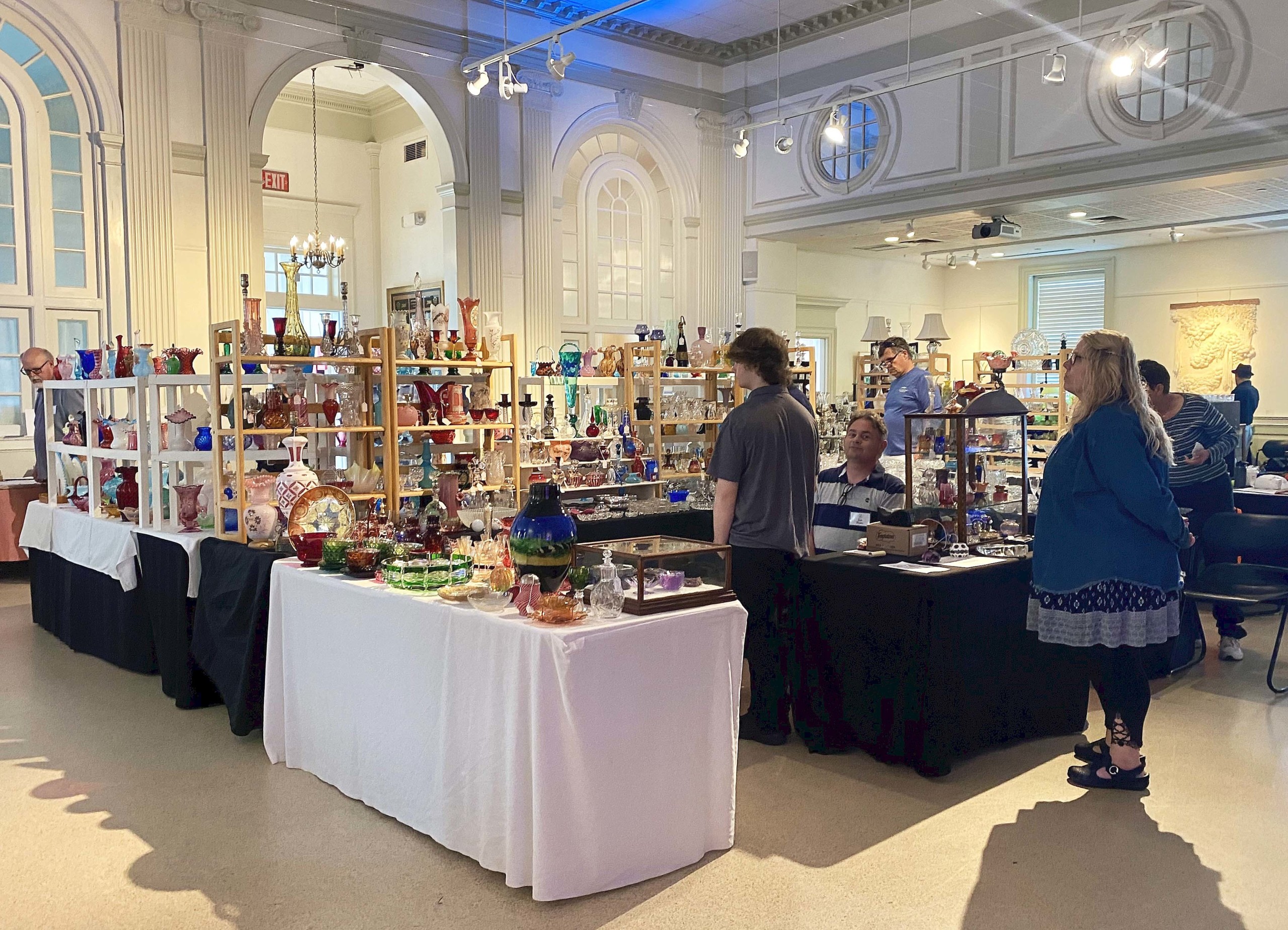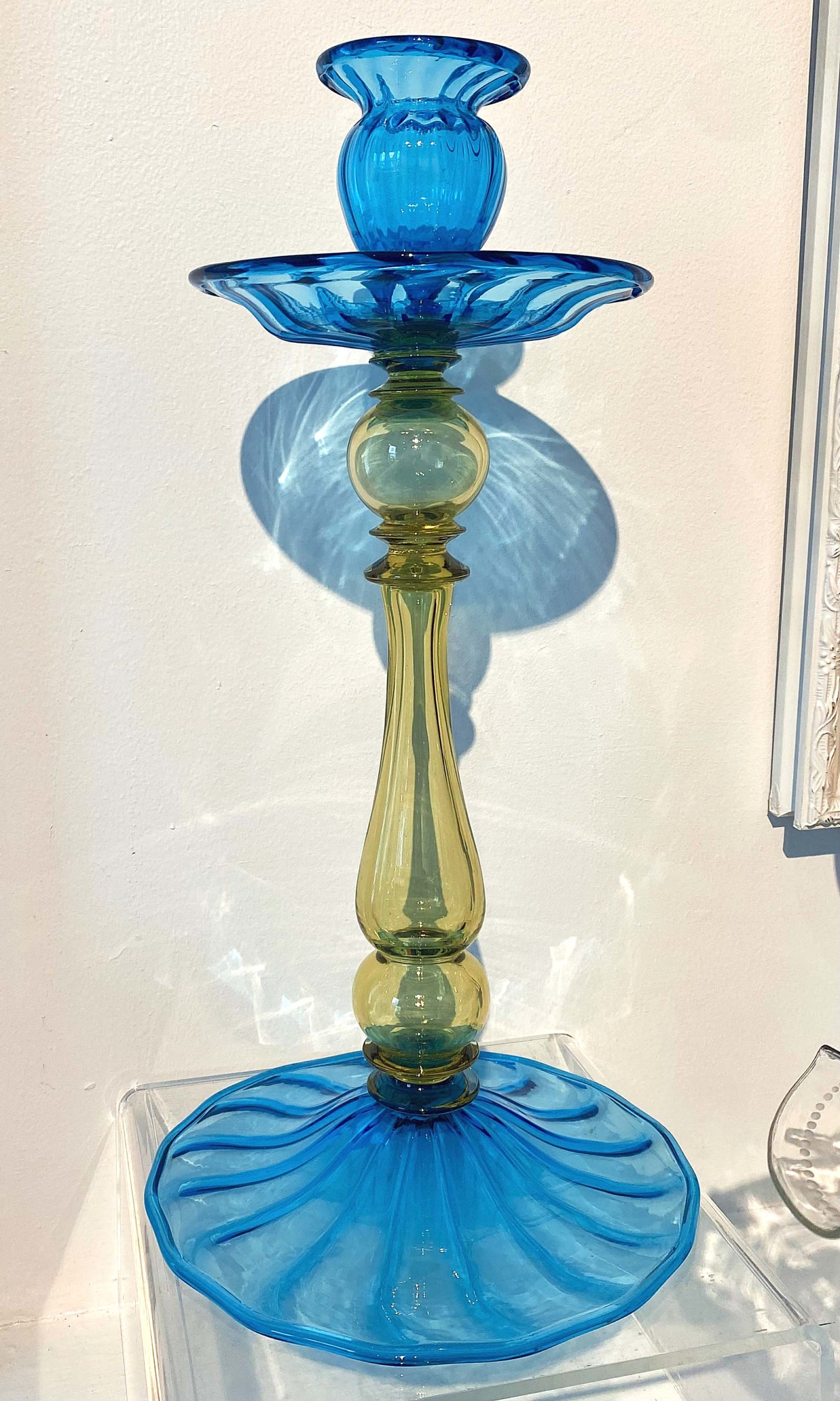
The Cultural Center of Cape Cod’s main exhibition space; if they could, vendors would surely stack their wares to the ceiling.
Review and Photos by Z.G. Burnett
YARMOUTH, MASS. — Cape Cod endured a bonafide Nor’easter for a couple of days leading up to the weekend of September 21 and 22, coinciding with the Cape Cod Glass Club’s (CCGC) 36th Annual Glass Show. Hosted by the Cultural Center of Cape Cod in Yarmouth, Mass., a Nineteenth Century bank turned art gallery and event space, the CCGC and the show’s dealers were well-protected from the torrential rain that was scheduled to come down through Saturday night. This forecast would usually dampen the spirits and sales of other shows, but the weather prompted a surprising surge of customers for the 13 dealers present.
“We had almost 200 people come in yesterday,” CCGC president Betsy Lessig reported happily on Sunday, “with 300 overall.”
Although a comparatively small show, the CCGC vendors always bring an impressive volume and variety. Glass dealers and collectors are often maximalists by nature and, according to a stereoview souvenir card from the New Bedford Museum of Glass’s table, this tendency is often as old as the glassware itself. The double image showed an exhibit stall from the New England Glass Company, Boston, as it appeared during Philadelphia’s 1876 Centennial International Exhibition. The exhibition hall was designed by Henry Pettit and Joseph M. Wilson. A full service of cut glass and decanters was arranged in front of a tiered candelabra, decorated with applied taper holders and hanging crystals in the manner of a chandelier. An identical stereoview card exists in The Library Company of Philadelphia, which refers to this ornament as a “table chandelier.”

Made in 2005 especially for The Stretch Glass Society, Sunbury, Penn., by the Fenton Art Glass Company, Martins Ferry, Ohio, these candy dishes were hand decorated in celebration of SGS’s 50th anniversary.
The Stretch Glass Society (SGS), Sunbury, Penn., brought their own commemorative and archival goods, but for display only. To mark its 50th anniversary, SGS decorated a set of candy dishes that was designed and made for the Society by the Fenton Art Glass Company, Martins Ferry, Ohio, in 2005. SGS mostly brings antique examples of stretch glass to educate visitors about its unique properties. Stretch glass was produced between 1916 and 1932, after which the iodized salt that caused the glass’s iridescence became too costly. Depression glass followed stretch glass in form but lacked its signature sheen and texture.
The arrangement of newcomer Decades of Dust, East Falmouth, Mass., had a glowing debut at the show — literally. Shining under black lights was a sizable collection of Uranium glass, mostly from Czech and Moravian makers. Business owners Tele and Tim Saunders reported great sales for their first CCGC show, particularly because they were added to the vendors’ list at the last minute. The Saunders were also the youngest dealers at the show, spelling a bright green future for glass collecting.
There are some pieces that just jump out and they are often found in the booth of Rose Colored Glass, Ogunquit, Maine. One such object was an unusually tall Steuben candlestick fashioned together with eight separate gathers of delicate Celeste green and topaz glass. Made in Corning, N.Y., circa 1910 and 1920, the candlestick had carefully rolled edges to protect against chipping. Co-owner Julian Rogers explained the rarity of this variety, and that he had not seen its like before.

At about 16 inches tall, this delicate Steuben candlestick stood out even among the other fine offerings of Rose Colored Glass, Ogunquit, Maine.
Another unusual shade and shape was given pride of place in the booth of Bruce Mitchell, Orange, Conn., whose glass was some of the earliest presented at the show. Positioned on the highest shelf was an English decanter, rare not only for its blue-green color but also its early Nineteenth Century dating. The decanter is decorated with relief-molded “raspberry prunts” that also served a practical purpose. “People back then, they didn’t wash their hands that much,” Mitchell explained. “So, if someone is drinking and their hands are greasy, the prunts give a better grip.”
In our water pump age of custom, 20-gallon home aquariums, it’s almost unthinkable for any pet fish owner to fill a glass globe and plop one or two into the unfiltered water. C&J’s Antiques, Norfolk, Mass., had just such an ornament from that time. But oh, what a fishbowl it was! Made from Vaseline glass, the bowl was mounted on an Art Deco Frankart stand, secured by three nudes. The fishbowl’s shape was common for aquariums at this time, as was the use of Vaseline and Uranium glass, but the stand was rare, according to co-owner Jim Watson. Its base showed “Frankart, Inc,” in raised letters as well as “patent applied,” and it might be unique.
Animal motifs, whether carved, blown or molded, have been popular with makers and collectors since prehistoric times and James Poore Antiques, Sagamore, Mass., brought a striking and unexpected example of the craft. Standing more than a foot tall on one of his tables was a thick glass vase showing the, perhaps unintentionally, nervous face of a cheetah. This image was achieved with a single slab of glass that was decorated with different colors, then molded into shape; its seam was visible verso, but this did not detract from the impressive result. The vase was dated and signed on the bottom by Kathleen Sheard and Lynn Read’s Vitreluxe glass blowing team.

Blown by a team of craftspeople including Kathleen Sheard and Lynn Read, the cheetah design of this 2007 vase was achieved by decorating a flat slab of hot glass, then joining the ends together.
Reproductions would not normally be shown at an antique glass show, let alone have their own table, but those authorized by the Sandwich Historical Society are a different story. Local craftspeople David McDermott and Yukimi Matsumoto of the McDermott Glass Studio used original Boston and Sandwich Glass presses, each with a proprietary pattern. These included the well-known Dolphin Candlesticks, drinking glasses and pitchers with Ribbed and Diamond Quilted Sunburst patterns, and lead crystal cup plates showing Leaf and Scroll and Heart and Diamond designs. Blown glass pumpkins by McDermott, Matsumoto, Kate Thomas and Peter Waechter were also offered for the season.
The Sandwich Glass Museum’s booth sat beside this table, displaying a refreshingly utilitarian assortment of industrial bottles. While carrying out renovations at the museum, explained Olivia Padula, curator of collections, crates of “digger” bottles were found in storage. Rather than discard or donate them, the museum contacted expert Chris Powell, who helped them price each affordable bottle. All proceeds went to the museum.
Padula only began her curatorship in February of this year, yet she joined the museum much earlier as a volunteer and then an intern. “Olivia is indispensable to us,” said director Mary Childs. The museum’s next special exhibit, “From the Maker’s Hands,” will “detail the earliest stages of the glass making and designing process, from conception to the finished product,” highlighting (usually female) workers’ contributions to Sandwich glass’s patterns and designs. Showcasing hand-drawn sketches and paintings from the museum’s archives, “From the Maker’s Hands” opens on November 15.

These small bottles will no doubt be familiar to veteran “diggers,” and were just some of hundreds found in the Sandwich Glass Museum’s basement during recent renovations.
Diminutive pressed glass toys were found across the aisle at the Cape Cod Glass Clubs’ booth. These early to mid-Nineteenth Century toy pieces lacked none of the standard sizes’ details, having been made from their own, tiny molds. A handleless cup and saucer, probably Midwestern, was generously documented and extremely rare in its bright cobalt color. Its neighbor, a 1830-50 blue-green toy tumbler or taster from the Boston and Sandwich Glass Company, showed a similar “lacy” pattern but was otherwise a stylistic contrast from the Midwestern cup and saucer.
Betsy Lessig, Yarmouth Port, Mass., showcased her own booth of early American pattern glass. The majority of these were clear glass, making it even easier to see the many design and pattern varieties presented. One central arrangement of a decanter and rocks glasses, all made from Flint glass, illustrated this perfectly. The decanter showed a Five Row Arrow pattern and was surrounded by no fewer than eight separate patterned glasses with names such as New English Pineapple, Bull’s Eye with Diamond (also known as Owl), Grooved Bigler and Comet. Despite these differences, they still showed well as a set.
One of the show’s most unexpected objects was brought by Andrew Daniels of Andrew’s Antiques, Chaplin, Conn., an oversized amber glass flower frog. Possibly named “frogs” because of how they sat in water to anchor floral arrangements, this example most resembled an American Bullfrog in size and weight, measuring about eight inches across and weighing about five pounds. Daniels shared that this frog came from one of the four most prominent mansions in Newport, R.I., where it was once used to keep the stems of large, heavy flowers and other greenery in place.
The Cape Cod Glass Club meets monthly at the Sandwich Public Library, 129 Main Street, Sandwich, Mass. For information, 508-776-9098 or www.capecodglassclub.org.




























